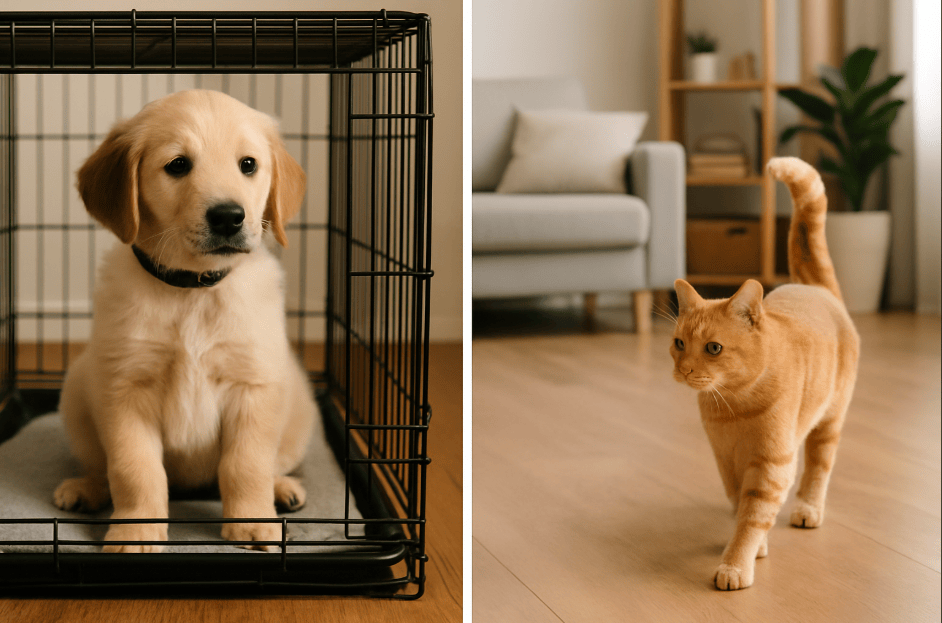As a pet parent, deciding between crate training vs free roam for your dog can feel overwhelming. You want what’s best for your furry friend—whether it’s ensuring their safety while you’re away or promoting good behavior during the day and night. This comparative guide explores the pros and cons of both approaches, when to use each, and how to make an informed decision based on your dog’s personality and needs.

Understanding the Purpose of Crate Training
Crate training uses a secure enclosure to create a safe, den-like environment for your dog. It’s commonly used for housebreaking puppies, preventing destructive behavior, and helping dogs settle at bedtime or while home alone. According to the American Kennel Club, when used properly, crates are not punishment—they’re a source of comfort.
What Does Free Roam Mean for Dogs?
Free roaming allows dogs unrestricted or minimally restricted access to parts—or all—of your home. Dogs can move around, nap in different spots, and explore their environment. This approach is typically reserved for dogs that are fully house-trained and have earned their owner’s trust.
Benefits of Crate Training
1. Safety and Security
Crates prevent dogs from getting into dangerous situations—chewing cords, eating toxic items, or falling down stairs—especially when you’re not home.
2. Effective House Training
Most dogs won’t soil their sleeping area. This helps teach bladder and bowel control.
3. Travel and Vet Visit Preparation
A dog that’s comfortable in a crate is easier to transport and less stressed during travel or hospitalization.
4. Encourages Calm Behavior
Crates offer dogs a space to retreat and relax. Over time, many dogs voluntarily rest in their crates during noisy or busy times.
Drawbacks of Crate Training
1. Overuse Can Lead to Anxiety
If a crate is used for excessive hours, it can lead to boredom, depression, or separation anxiety.
2. May Not Suit All Personalities
Some rescue dogs or adult dogs with traumatic histories may have negative associations with confinement.
Benefits of Free Roaming
1. Freedom and Mental Stimulation
Dogs can follow their instincts—like watching out windows or playing with toys—when they have more room.
2. Strengthens Trust
Allowing your dog to roam shows you trust them, which can enhance your bond.
3. Comfort and Routine
Dogs enjoy establishing their own sleeping spots and daily routines, similar to how we do.
Potential Downsides of Free Roaming
1. Risk of Destruction or Injury
Untrained or anxious dogs might chew furniture, get into the trash, or cause accidents.
2. Harder to Monitor Behavior
You may not notice accidents or signs of illness (like unusual bowel habits) if your dog is unsupervised in large areas.
Which Dogs Thrive with Crate Training?
- Puppies
- Dogs new to your home
- Anxious dogs who need structure
- Dogs recovering from surgery
Crate training can also be ideal for owners who work outside the home and want to ensure their dog is safe while alone.
Which Dogs Do Best with Free Roam?
- Fully house-trained adult dogs
- Dogs with low anxiety
- Dogs in multi-pet households who like company
- Dogs who don’t chew or destroy household items
According to PetMD, adult dogs with strong routines and impulse control often thrive with freedom.
How to Transition from Crate to Free Roam
- Start Small: Open access to one room, preferably familiar.
- Observe Behavior: Use a pet cam if you’re not home.
- Reward Calmness: Offer praise or treats after successful sessions.
- Gradually Expand Freedom: Increase access slowly based on behavior.
Consistency is crucial. If issues arise, return to shorter free roam sessions.
Expert Tips and Real-World Experiences
Most pet owners don’t realize how much their dog’s personality and energy level should guide their approach. I crate-trained my dog, Max, during his first year. At first, it helped reduce his separation anxiety. But by the time he was two, he started resting under the couch instead of going into his crate. I took that as a sign he was ready for more freedom—and he hasn’t chewed a thing since.
Many experienced trainers suggest using crates and free roam in combination—especially during the transition period.
For additional safety tips, explore our full range of training guides at fluffze.com.
FAQ
Is crate training cruel?
No, when used properly, crates offer comfort and structure. They should never be used for punishment.
How long can I leave my dog in a crate?
Puppies: 2–4 hours. Adult dogs: up to 6–8 hours if needed. Always ensure exercise and bathroom breaks before and after.
Can I switch from crate to free roam later?
Yes. Many dogs start with crate training and transition to free roaming over time.
Should I crate my dog at night?
If they sleep better and stay calm in a crate, yes. Otherwise, free roam in a dog-proofed area may be fine.
Can I mix both approaches?
Absolutely! Many owners use the crate for travel, vet visits, or high-stress situations but allow free roam at home.
Final Thoughts
Choosing between crate training vs free roam isn’t a one-size-fits-all decision. It depends on your dog’s age, temperament, training level, and your lifestyle. The key is observing what makes your dog feel safest, calmest, and most content.
Some dogs love the security of a crate, while others flourish with the freedom of roaming the house. Ultimately, your pet’s comfort and safety come first.
Written by Author Box
Written by Shawn, pet lover & contributor at Fluffze
Related Articles:
Crate Training Mistakes to Avoid: Setting Your Dog Up for Success
Potty Training Mistakes to Avoid for puppies
Group Dog Training Classes vs Private Sessions





